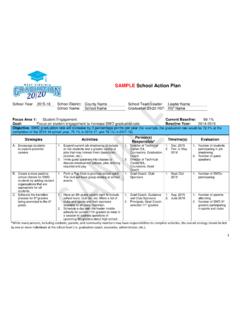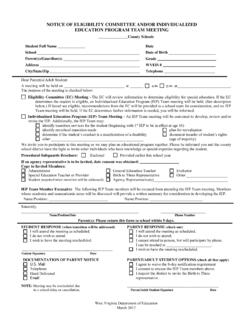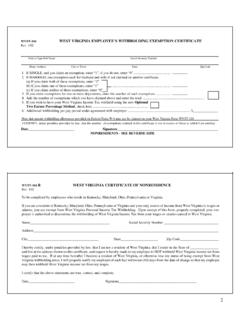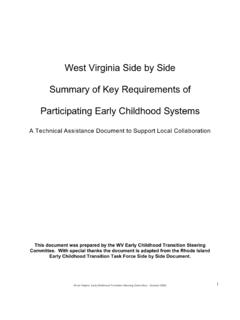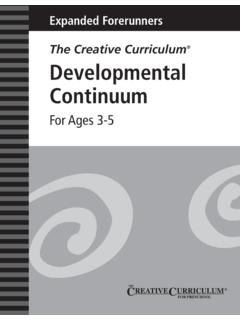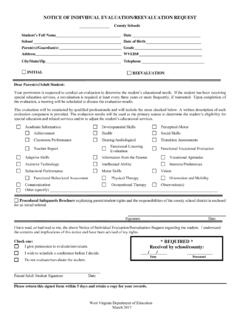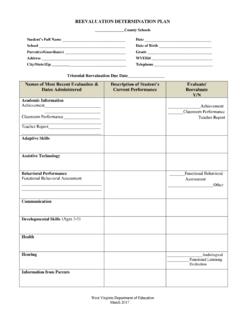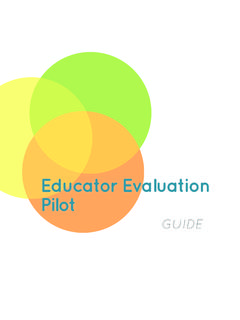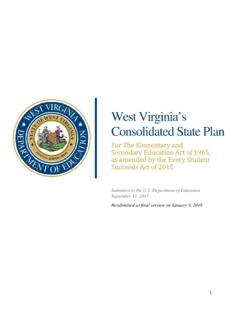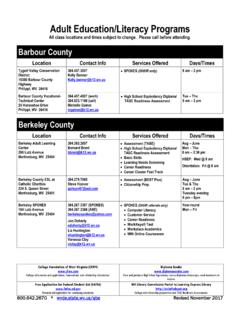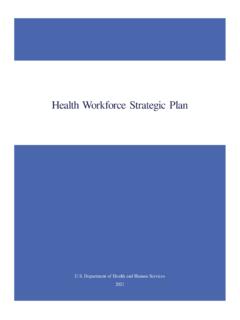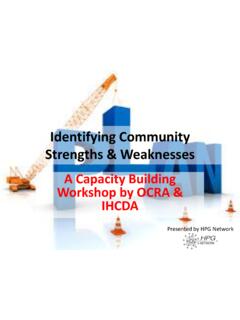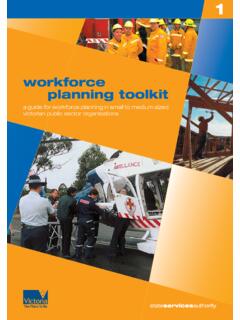Transcription of Section 5 Identifying Strengths and Weaknesses
1 WVAdultEd Instructor Handbook 2017-18 Section 5 Identifying Strengths and Weaknesses Adult education (AdultEd) Program Office of Adult education and workforce Development west virginia department of education The west virginia Adult education (WVAdultEd) Program is funded by the Adult education and Family Literacy Act, enacted August 7, 1998 as Title II of the workforce Investment Act of 1998. WVAdultEd is administered through the west virginia department of education Office of Adult education and workforce Development, Building 6, Room 230, 1900 Kanawha Boulevard, East, Charleston, west virginia 25305-0330. The WVAdultEd Instructor Handbook is produced by the WVAdultEd Professional Development Program, whose fiscal agent is the Regional education Service Agency (RESA) 3, 501 22nd Street, Dunbar, west virginia 25064-1711.
2 For questions or concerns related to the content of the WVAdultEd Instructor Handbook, contact Cathy Shank at the WVAdultEd Hotline, 1-800-642-2670, or via email at RESA 3 does not discriminate on the basis of race, color, religion, sex, national origin, age, disability, or any other characteristic protected by law in access to, employment in, or provision of any of RESA 3 s programs, benefits, or activities. 5 Identifying Strengths and Weaknesses INTERVENTIONS REQUIRED BY THE WVADULTED PROGRAM .. 1 ASSESSING LEARNING STYLES 2 LEARNING STYLES VERSUS LEARNING DISABILITIES .. 2 LEARNING STYLES INSTRUMENTS .. 2 SCREENING FOR BARRIERS AND SPECIAL LEARNING NEEDS .. 5 RECOMMENDED SCREENING INSTRUMENTS .. 5 USING SCREENING INSTRUMENTS.
3 6 Identifying RESOURCES AND ADDRESSING BARRIERS 7 ACCESSING COMMUNITY RESOURCES .. 7 ADDRESSING BARRIERS AND SPECIAL NEEDS .. 8 WEIGHTED ATTENDANCE/CONTACT HOURS FOR STUDENTS WITH DISABILITIES .. 9 MAKING REQUESTS FOR INFORMATION TO OBTAIN DOCUMENTATION FOR STUDENTS WITH DISABILITIES .. 10 MAKING REFERRALS FOR PSYCHOLOGICAL ASSESSMENT .. 11 APPENDIX 13 INTERVENTION INSTRUMENTS .. 15 LEARNING STYLES INSTRUMENT WORKSHEET .. 17 BACKGROUND ON THE CENTER FOR INNOVATIVE TEACHING EXPERIENCES ( ) LEARNING STYLES INSTRUMENT .. 18 LEARNING STYLES INSTRUMENT .. 19 DEFINITIONS AND TEACHING TECHNIQUES FOR LEARNING STYLES .. 21 LEARNING STYLE PREFERENCE FORM .. 25 LEARNING STYLE PREFERENCE SCORING FORM .. 27 LEARNING NEEDS SCREENING INSTRUMENT .. 29 LEARNING NEEDS SCREENING DIRECTIONS.
4 30 LEARNING NEEDS SCREENING .. 31 PLAN FOR REDUCING BARRIERS TO SUCCESS .. 37 REQUEST AND REFERRAL FORMS .. 39 REQUEST FOR INFORMATION .. 41 SPECIAL LEARNING NEEDS 42 TESTING ACCOMMODATIONS ATTACHMENT .. 44 This page intentionally left blank. WVAdultEd Instructor Handbook, Section 5, 2017-18 1 INTERVENTIONS REQUIRED BY THE WVADULTED PROGRAM It is important to determine students Strengths and Weaknesses at the outset to help them know what goals will be realistic and how to proceed with a plan of study. WVAdultEd programs are required to administer some type of screening instrument, questionnaire, and/or inventory (or a combination) to each student and to make interventions in the student learning plan based on the results. The intervention instrument(s) must include: Learning styles (auditory, visual, tactile, social, etc.)
5 Identification questions that will help you and your students identify materials and techniques that are best suited to their Strengths . Barrier identification questions (about problems with transportation, scheduling, child care, health, family issues, etc.) that will help you assist the students in Identifying potential problems and developing a plan to address these issues. Special learning needs screening questions that will tip you off to learning disabilities, attention deficits, and other special learning needs ( , vision or hearing problems, medical issues, etc.) so that you can identify appropriate strategies and accommodations or make referrals for formal diagnoses. Different programs use different intervention instruments or combinations of instruments to screen and follow-up on students.
6 There are several instruments within this handbook that contain one or more of the required intervention instruments. These can be found in the Section 5 Appendix. SPOKES classes are required to use particular instruments (see Section 16). In addition to simply screening students, your program is required to follow-up by explaining the screening results, developing individual strategies to address the problem areas, making referrals to outside agencies as needed, and documenting this process. Students with documented disabilities and other special needs should not be turned away. On the contrary, it is your job to find appropriate strategies and resources to assist them. Adults who struggle to attend your program due to barriers in their lives need your assistance.
7 WVAdultEd Instructor Handbook, Section 5, 2017-18 2 ASSESSING LEARNING STYLES As adult educators, we need to become more aware of different modes of learning. The tendency of most instructors is to deliver educational input in their own preferred style. Many times our students have had difficulty in the learning environment because they only received one type of input. Learners are often more successful when they receive input in their preferred learning style (visual, auditory, tactile, kinesthetic, etc.). It is important to help each learner become aware of his or her learning style and to provide appropriate input to enhance learning. Learners who are aware of how they best receive input can choose appropriate materials and settings to work in as part of their plan of study.
8 Instructors who pay attention to student learning styles offer choices in how students receive input and demonstrate their learning. Learning Styles versus Learning Disabilities All of us learn through our senses. We obtain information from a variety of modalities. Our preferred modalities are our learning styles. Some adults have impairments in one or more of their learning modalities caused by learning disabilities (LD). Adults with learning disabilities can ONLY receive information from their intact learning modalities. Thus, for an adult with LD, his or her learning style is not simply a preference; it is mandatory. Adults with learning disabilities MUST receive information in particular ways, or they cannot process the information and, therefore, cannot learn it.
9 For example, adults with auditory processing disabilities have problems hearing and understanding oral instructions. They must have written instructions to know what to do. In contrast, those with dyslexia may struggle with written text, but find the audio feature on some computer programs to be extremely helpful or even necessary. While discerning one s learning style is valuable to almost any adult learner, it may be a vital step for an adult with learning disabilities. It may provide you with the key to how a particular learner needs to receive and process information. Learning Styles Instruments A variety of instruments are available to help adult learners discover their preferred learning styles. Find out if your local program requires that you use specific instruments and which one(s).
10 Because they may be freely reproduced, many WVAdultEd programs use the one of the following instruments: The ( Section 5 Appendix) instrument distinguishes between learners who prefer visual-language, visual-numerical, auditory-language, auditory-numerical, auditory-visual-kinesthetic, social-individual or social-group. SPOKES instructors are required to use the WVAdultEd Instructor Handbook, Section 5, 2017-18 3 Note: An Excel version that will automatically score the instrument is available for download at . (Be sure to click on the Summary tab at the bottom of the page to access the results worksheet.) The Learning Style Preference Form ( Section 5 Appendix) from Linn-Benton Community College determines whether the student is a visual, auditory, tactile, or social learner.
